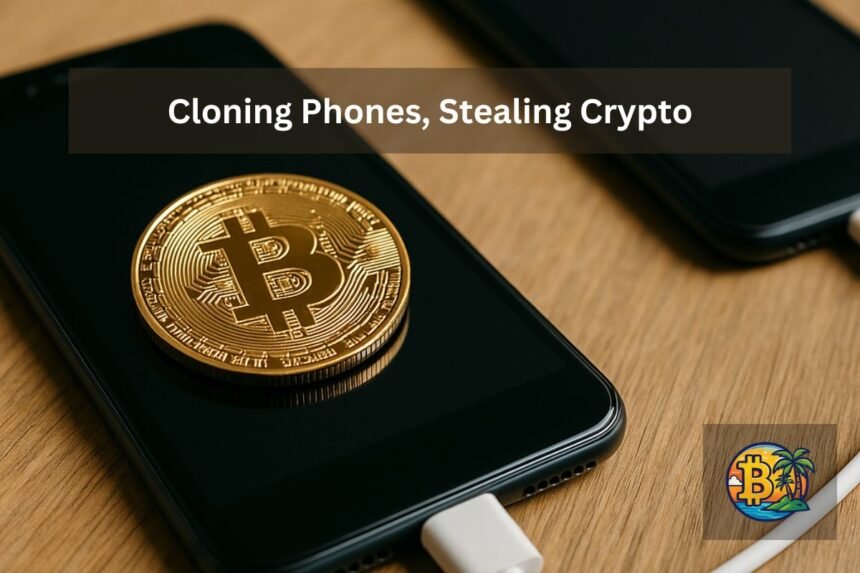Key Insights
- Most people in the crypto space tend to have their smartphones as the gateway to their holdings.
- Hackers can either steal these devices or even take control of any phone to drain funds.
- Contrary to what “phone cloning” might mean in the movies, hackers do not “build a digital replica” of your device.
- They instead take over your phone’s functions by attacking its weak points, especially your phone number and software vulnerabilities.
- Phone-based crypto theft is becoming more and more of a problem over the years. However, it is not unstoppable.
Most people in the crypto space tend to have their smartphones as the gateway to their holdings.
This makes sense because everything from mobile wallets to exchange apps now have installable versions on mobile devices.
However, this convenience comes with its own set of risks.
Hackers can either steal said devices or even take control of any phone to drain funds.
Contrary to what “phone cloning” might mean in the movies, hackers do not “build a digital replica” of your device.
Instead, they hijack important elements like your phone number or access to your apps.
Here’s how it works, and how you can protect yourself.

The Truth About Phone Cloning
When people hear “phone cloning,” they often get flashbacks of some movie, and imagine an exact copy of their phone being created in an instant.
Same apps, same data, same behavior.
In reality though, real cloning of both hardware and software is extremely rare, thanks to security features like unique device identifiers (IMEI numbers).
These fail safes make it nearly impossible to duplicate a device.
What hackers can do, however, is a lot more sinister.
They take over your phone’s functions by attacking its weak points, especially your phone number and software vulnerabilities.
These hackers do this to gain control of your digital identity and access the services you use to manage your crypto.
SIM Swapping
One of the most popular ways of phone cloning is SIM swapping, or SIM jacking. This approach involves transferring your phone number to a SIM card they control.
They typically follow a set of steps, as outlined:
Gathering Your Personal Info:
To start with, hackers collect information like your full name, date of birth, address, and phone number. This data tends to come from leaked databases, phishing attacks, social media or even direct access to you.
Tricking Your Carrier
Once this information has been collected, they contact your mobile provider pretending to be you. They claim their phone (or in this case, your phone) was lost or stolen, and request your number be moved to a new SIM card.
Gaining Control
Once the swap is successful, your phone suddenly loses service and you’ll have no idea why. The hacker on the other hand, now receives your calls and texts.
Breaking Into Your Accounts
Most crypto exchanges use SMS-based two-factor authentication (2FA). Now that the attacker has your number, they can receive these 2FA codes, reset passwords, and gain access to your crypto accounts.
Before you know what’s happened, your funds are gone.
Malware
Hackers sometimes take other popular approaches to stealing your crypto. Instead of swapping your SIM card, they install malware that is designed to spy on you, steal credentials and hijack your transactions.
Some common types of mobile malware include Fake Apps and Trojans, whee they disguise scam apps as legit ones like crypto wallets, chat apps or even a calculator.
These apps can record your keystrokes or conversations, take screenshots or even give the attacker(s) backdoor access to your phone.
Another popular kind is with Clippers (or Clipboard Hijackers).
Crypto users tend to copy wallet addresses to send funds, and clipper malware take advantage of this by quietly changing the copied address to the hacker’s address.
If you’re not paying close attention, you’ll send money to the wrong person and not even realize it.
Finally, hackers favor spyware, which can track almost everything you do on your device.
They can capture passwords, recovery phrases and other kinds of sensitive information.
Sometimes, even if hackers can’t access your phone directly, they might still get to your data by breaking into your cloud backups.
If your iCloud or Google Drive contains app data, passwords, or recovery phrases, it could turn out to be a goldmine for attackers.
How to Stay One Step Ahead?
Fortunately, there are simple (yet powerful) ways to protect yourself against these types of attacks.
For starters, avoid SMS 2FA altogether. Instead, use authenticator apps like Google Authenticator or Authy.
If you need even better protection, use a hardware key like YubiKey.
Remember to always use strong and unique passwords. Make sure each of your accounts (especially email and crypto related ones) have its own complex password. Set a SIM PIN for that extra kick of security. This means that even if someone gets your SIM, they can’t activate it without the PIN.
Remember to always keep your software updated and download only from official stores.
Avoid third-party apps unless you absolutely trust the source and never click on suspicious links or enter login details on strange sites.
Remember to always double-check URLs and emails. Check your phone bill for unexpected activity and review your crypto account security regularly, to make sure that nobody has unauthorized access.
Finally, limit what you share online and consider a hardware wallet.
The less personal information you expose on social media, the harder it is for attackers to impersonate you.
Large amounts of crypto would be safer within a hardware wallet, which keeps your private keys completely out of reach from phone-based attacks.
Phone-based crypto theft is becoming more and more of a problem over the years. However, it is not unstoppable.
Understanding the tactics that hackers take and taking the steps to prevent them could be the key to securing your device and accounts.
Be smart and never take mobile security lightly, because your crypto may depend on it.








